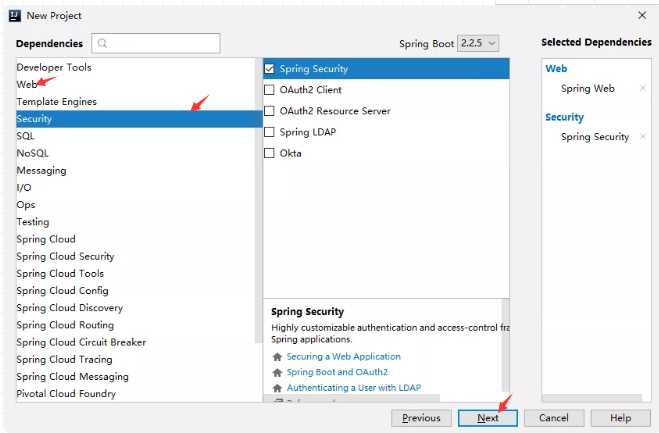SpringSecurity 入门
2021-02-06 23:17
标签:定义 rate lse dex ESS eval ppa 上下 png 1.首先新建一个 Spring Boot 项目,创建时引入 Spring Security 依赖和 web 依赖,如下图: 2.项目创建成功后,Spring Security 的依赖就添加进来了,在 Spring Boot 中我们加入的是 我们添加一个测试的 HelloController,内容如下: 3.我们直接来启动项目,在项目启动过程中,我们会看到一行日志:Using generated security password:一串uuid的数字----------这就是为默认用户user生成的 密码 4.接下来我们去访问 5.登录时,默认的用户名就是 user,默认的登录密码则是项目启动时控制台打印出来的密码,输入用户名密码之后,就登录成功了,登录成功后,我们就可以访问到 /hello 接口了。 【注】在 Spring Security 中,默认的登录页面和登录接口,都是 的路径)。 【注】用户相关的自动化配置类在 1.application.properties配置 2.配置类中配置用户名/密码。 (1)首先我们自定义 MySecurityConfig 继承自 WebSecurityConfigurerAdapter,重写里边的 configure (AuthenticationManagerBuilder auth) 方法 解释: 1.提供了一个 PasswordEncoder 的实例,因为目前的案例还比较简单,因此暂时先不给密码进行加密,所以返回 NoOpPasswordEncoder 的实例即可。 2. configure 方法中,我们通过 inMemoryAuthentication 来开启在内存中定义用户,withUser 中是用户名,password 中则是用户密码,roles 中是用户角色。 3.如果需要配置多个用户,用 and 相连。and 符号相当于就是 XML 标签的结束符,表示结束当前标签,这是个时候上下文会回到 inMemoryAuthentication 方法中,然后开启新用户的配置 1.继续完善前面的 MySecurityConfig 类,继续重写它的 四.登录成功回调(前后端不分离) 五.登录失败回调(前后端不分离) 1.failureForwardUrl 是登录失败之后会发生服务端跳转, 2.failureUrl 则在登录失败之后,会发生重定向。 六.注销登录 注销登录的默认接口是 七.前后端分离的登录成功和登录失败的回调 1.登录成功 successHandler successHandler 方法的参数是一个 AuthenticationSuccessHandler 对象,这个对象中我们要实现的方法是 onAuthenticationSuccess。 onAuthenticationSuccess 方法有三个参数,分别是: 1.HttpServletRequest //可以做服务端跳转 2.HttpServletResponse //可以做客户端跳转 3.Authentication //保存了我们刚刚登录成功的用户信息 2.登录失败 failureHandler 第一第二个参数和登录成功的参数一样,第三个是一个 Exception,对于登录失败,会有不同的原因,Exception 中则保存了登录失败的原因 八 注销登录 (前后端分离) 前后端分离 之后,返回的是json SpringSecurity 入门 标签:定义 rate lse dex ESS eval ppa 上下 png 原文地址:https://www.cnblogs.com/xp0813/p/12778949.html一.新建项目

spring-boot-starter-security@RestController
public class HelloController {
@GetMapping("/hello")
public String hello() {
return "hello";
}
}
http://localhost:8080/hello 接口,就可以看到自动重定向到登录页面了:
/login ,只不过一个是 get 请求(登录页面:即登录时看到的页面),另一个是 post 请求(登录接口:即登录页面被提交UserDetailsServiceAutoConfiguration 里边二.不使用数据库怎么自定义用户名密码?
spring.security.user.name=用户名
spring.security.user.password=密码
@Configuration
public class MySecurityConfig extends WebSecurityConfigurerAdapter {
@Bean
PasswordEncoder passwordEncoder() {
return NoOpPasswordEncoder.getInstance();
}
@Override
protected void configure(AuthenticationManagerBuilder auth) throws Exception {
auth.inMemoryAuthentication()
.withUser("xxx")
.password("123").roles("admin");
}
}
三.自定义表单登录页
configure(WebSecurity web) 和 configure(HttpSecurity http) 方法,如下:@Override
public void configure(WebSecurity web) throws Exception {
//web.ignoring() 用来配置忽略掉的 URL 地址,一般用于静态文件
web.ignoring().antMatchers("/js/**", "/css/**");
}
@Override
protected void configure(HttpSecurity http) throws Exception {
http.authorizeRequests()
.anyRequest().authenticated()
.and()
.formLogin()
.loginPage("/login.html") //登录页面的地址
.loginProcessingUrl("/loginSecuss") //登录接口的地址,如果不配置,默认和登录页面路径一样,只不过登录页面是get请求,登录接口是post请求
.usernameParameter("name") //可以修改登录页面默认的userName用户名
.passwordParameter("passwd")//可以修改登录页面默认的password密码 .permitAll()
.and()
.csrf().disable();
}
/index,此时分两种情况,如果你是直接在浏览器中输入的登录地址,登录成功后,就直接跳转到 /index,如果你是在浏览器中输入了其他地址,例如 http://localhost:8080/其他页面路径,结果因为没有登录,又重定向到登录页面,此时登录成功后,就不会来到 /index ,而是来到 /其他页面路径 。
/index ,你在浏览器地址栏输入 http://localhost:8080/hello,结果因为没有登录,重定向到登录页面,当你登录成功之后,就会服务端跳转到 /index 页面;或者你直接就在浏览器输入了登录页面地址,登录成功后也是来到 /index。/logout,我们也可以配置.and()
.logout()
.logoutUrl("/logout")
.logoutRequestMatcher(new AntPathRequestMatcher("/logout","POST"))
.logoutSuccessUrl("/index")
.deleteCookies()
.clearAuthentication(true)
.invalidateHttpSession(true)
.permitAll()
.and()
/logout,是一个 GET 请求,我们可以通过 logoutUrl 方法来修改默认的注销 URL。.successHandler((req, resp, authentication) -> {
Object principal = authentication.getPrincipal();
resp.setContentType("application/json;charset=utf-8");
PrintWriter out = resp.getWriter();
out.write(new ObjectMapper().writeValueAsString(principal));
out.flush();
out.close();
})
.failureHandler((req, resp, e) -> {
resp.setContentType("application/json;charset=utf-8");
PrintWriter out = resp.getWriter();
out.write(e.getMessage());
out.flush();
out.close();
})
.and()
.logout()
.logoutUrl("/logout")
.logoutSuccessHandler((req, resp, authentication) -> {
resp.setContentType("application/json;charset=utf-8");
PrintWriter out = resp.getWriter();
out.write("注销成功");
out.flush();
out.close();
})
.permitAll()
.and()
上一篇:GC算法
下一篇:part12:Python 文件I/O(pathlib模块:PurePath、Path,os.path,fnmatch,open,with,linecache,os模块操作文件和目录,tempfile